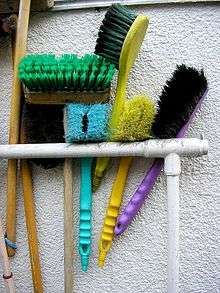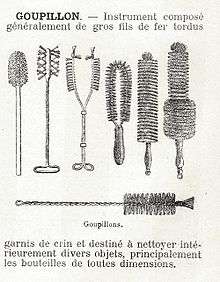Brush
A brush is a common tool with bristles, wire or other filaments. It generally consists of a handle or block to which filaments are affixed in either a parallel or perpendicular orientation, depending on the way the brush is to be gripped during use. The material of both the block and bristles or filaments is chosen to withstand hazards of its intended use, such as corrosive chemicals, heat or abrasion. It is used for cleaning, grooming hair, make up, painting, surface finishing and for many other purposes. It is one of the most basic and versatile tools in use today, and the average household may contain several dozen varieties.

History
When houses were first inhabited, homeowners used branches taken from shrubs to sweep up dirt, hence using the first brushes. In 1859, the first brush factory in America was set up in New York.[1]
Manufacture
A common way of setting the bristles, brush filaments, in the brush is the staple or anchor set brush in which the filament is forced with a staple by the middle into a hole with a special driver and held there by the pressure against all of the walls of the hole and the portions of the staple nailed to the bottom of the hole. The staple can be replaced with a kind of anchor, which is a piece of rectangular profile wire that is anchored to the wall of the hole, like in most toothbrushes. Another way to attach the bristles to the surface can be found in a fused brush, in which instead of being inserted into a hole, a plastic fibre is welded to another plastic surface, giving the option to use different diameters of bristles in the same brush.
Configurations include twisted-in wire (e.g. bottle brushes), cylinders and disks (with bristles spread in one face or radially).
By function
Removal of material (cleaning and polishing)

.jpg)
The action of these brushes is mainly in the tip of each flexible bristle which dislodges particles of matter.
- Archaeology brush
- Beekeeper's brush
- Bench-grinder brush
- Bottle brush: a long handled brush with rows of radial bristles, designed to fit into small mouthed bottles and access the larger interior.
- Broom (long-handled brush)
- Car-wash brush
- Chimney brush
- Chip brush
- Clothes brush, a brush for removing detritus from clothing
- Crumb brush
- Curling brush (sport)
- Dandy brush, for Horse grooming
- Dishwashing brush
- Floor brush (yard brush, yard broom, hand brush)
- Flue brush
- Gun-barrel brush
- Lavatory brush (toilet brush or slang bog brush)
- Milk-churn brush
- Nailbrush
- Neck Duster
- Rotary brush
- Scrubber
- Shoe-polish brush (buffer)
- Test tube brush
- Toothbrush
- Typewriter eraser brush
- Vacuum-cleaner brush
- Vegetable brush (mushroom brush)
- Wire brush
Application of material
The action of such brushes is mostly from the sides, not the tip, contact with which releases material held by capillary action.
- Finger-print forensic brush
- Gilding brush
- Ink brush
- Makeup brush
- Mascara brush
- Nail-polish brush
- Paintbrush (fine art or house decoration)
- Pastry brush
- Shaving brush
- Shoe-polish brush (polish applicator)
- Wall-paper brush
Combing
The action of these brushes is more akin to combing than brushing, that is they are used to straighten and untangle filaments. Certain varieties of hairbrush are however designed to brush the scalp itself free of material such as dead skin (dandruff) and to invigorate the skin of the scalp.
- Grooming brush
- Hair brush
Other
- Brush (electric), used on electrical motors
- Magnetic brush
- Medical sampling brush
- Brush percussion mallets
- Stippling brush (neither applies or removes material, but merely adds pattern)
Cleaning
Brushes used for cleaning come in various sizes, ranging from that of a toothbrush, to the standard household version accompanied by a dustpan, to 36″ deck brushes. There are brushes for cleaning tiny cracks and crevices and brushes for cleaning enormous warehouse floors. Brushes perform a multitude of cleaning tasks. For example, brushes lightly dust the tiniest figurine, they help scrub stains out of clothing and shoes, they remove grime from tires, and they remove the dirt and debris found on floors with the help of a dust pan. Specific brushes are used for diverse activities from cleaning vegetables, as a toilet brush, washing glass, cleaning tiles, and as a mild abrasive for sanding.
References
- Extraordinary Origins of Everyday Things. Reader's Digest. 27 November 2009. p. 29. ISBN 978-0276445699.
- The Grove Encyclopedia of Materials and Techniques in Art, Gerald W. R. Ward. Oxford University Press, 2008. ISBN 978-0-19-531391-8
- Glossary of Brush Terms
External links
| Wikisource has the text of the 1911 Encyclopædia Britannica article Brush. |
| Wikimedia Commons has media related to Brushes. |
| Look up brush in Wiktionary, the free dictionary. |